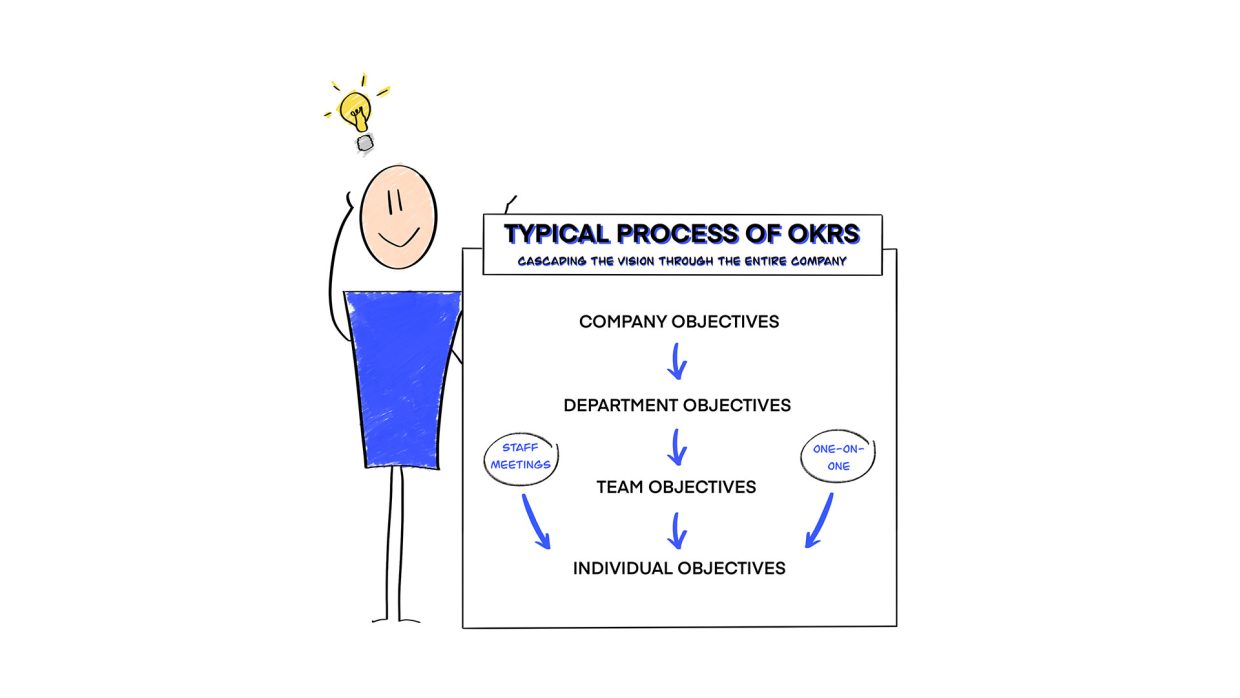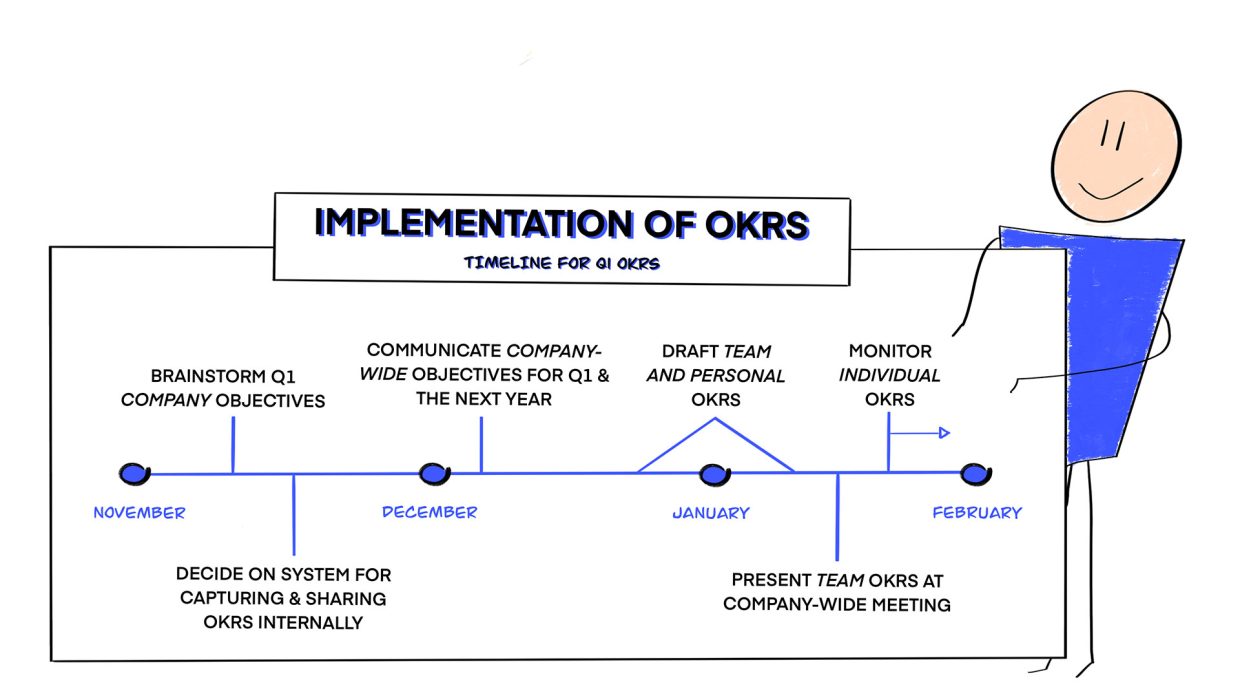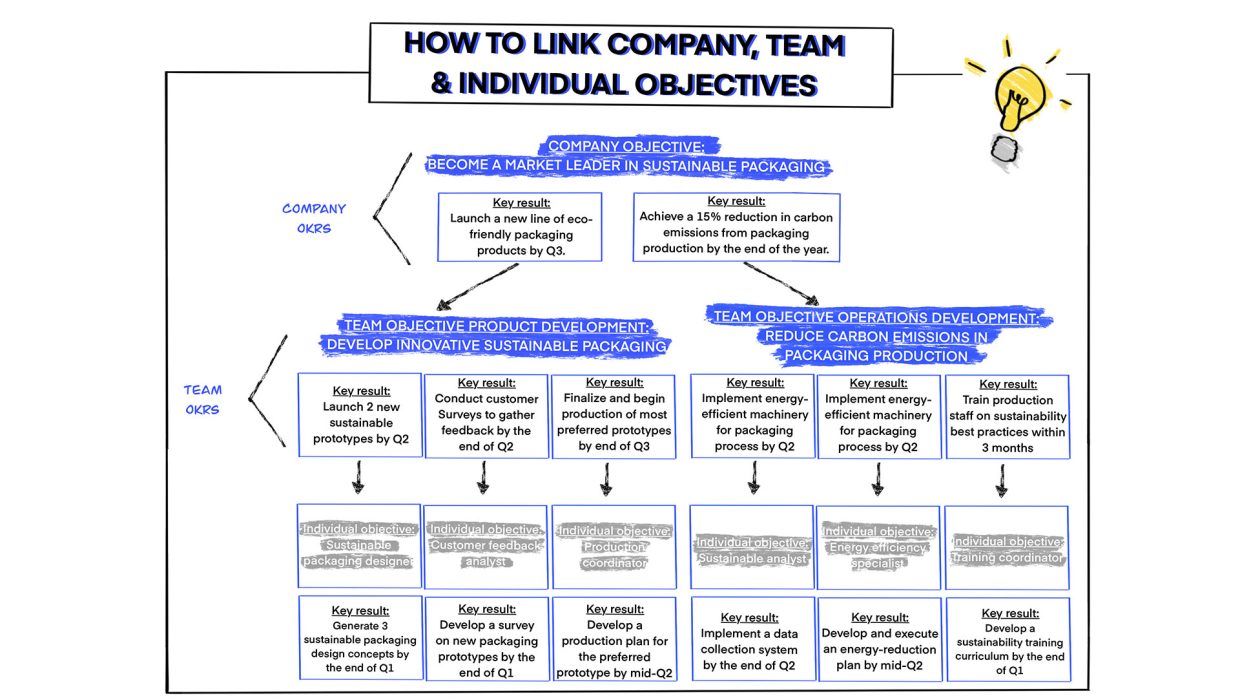“There is magic in every beginning.” These famous words of Hermann Hesse are known worldwide. But only very few have ever been able to experience this magic themselves. Especially in the work environment, you often must deal with sober and extremely objective innovations. But here, too, magic can work. A good example of this is the usage of Objectives and Key Results (OKRs). They can be a true sorcery for a fresh start. Because through them, everything works hand in hand towards a great goal.
But what exactly are the OKRs that so many are talking about at the moment? They are one of the tools that Google, for example, has used to become so successful. The success of the implementation of OKRs lies in its disciplined thinking, accurate communication, and focus on measurable indicators for progress. Companies can instill discipline throughout the entire number of employees and thus implement OKRs throughout the company across all hierarchical levels.
The key elements that have contributed to any success story with OKRs include setting ambitious yet achievable goals and venturing to the edge of the feasible. This move motivates employees to strive for greater things, reaching for the stars that seem so far away.
The consistent check-in of OKRs focuses on providing feedback for improvement rather than evaluation. Regular meetings ensure continuity. OKRs drive a virtuous cycle. At the end of each cycle, no matter if quarterly or yearly, OKRs are reviewed and adjusted to assess whether the objectives remain relevant. If necessary, adjustments are made to maintain focus on the essentials. So, the company can ensure that employees work in alignment with the company’s goals and do not waste their time.
DIFFERENTIATING BETWEEN OBJECTIVE AND KEY RESULT
But where to start if you dream of introducing OKRs to your company and want to take advantage of their benefits? First, you should understand the basic terms and define them appropriately for yourself. The Objective sets an ambitious goal and may feel slightly uncomfortable due to uncertainty. If you nail it easily, you may not be pushing hard enough or thinking broadly and big enough. In contrast, the Key Results play a crucial role in making the Objective achievable and must be quantifiable. They lead the way through the grading process of the Objective. “Crafting effective Objectives and Key Results can be challenging when faced with uncertainty.
For instance, if your initial Objective is to ‘Enhance customer satisfaction’, it may lack specificity and measurability,” explains P3 OKR expert and coach Oana Calugar. This is an often-made beginner’s mistake. To solve these problems, she advises: “Apply the SMART criteria by making it specific, such as ‘Increase customer satisfaction scores by 15% in the next quarter’, and set quantifiable Key Results aligned with this Objective. This ensures a clear, measurable, and ambitious target, making it easier to track progress and achieve success in improving customer satisfaction.”
The key to good Objectives and Key Results lies within five essential elements to ensure the effectiveness of OKRs.
- OKRs are set both quarterly and annually: They provide adaptability to the changing organizational environment. OKRs are not fixed in stone but can be revised based on added information, serving as directional aids rather than strict constraints.
- OKRs must be measurable: Quantifiable Key Results track progress and success. This measurability empowers teams to objectively evaluate their achievements and make data-driven decisions.
- OKRs are set at various levels: At the personal level, individuals define their contributions to the team’s goals. Team-level OKRs summarize the top three to five priorities that the company cares about, reflecting what a group of people is working on. Company-level OKRs align the entire organization towards shared Objectives.
- OKRs are publicly available to the entire company: It is critical for everyone in the organization, from the CEO down to every employee, to know what others are working on. This transparency fosters collaboration prevents duplication of efforts and promotes a unified understanding of organizational goals.
- OKRs are graded each quarter: Regular evaluation is essential for success. At the end of every quarter, OKRs are assessed to measure progress, recognize achievements, identify areas for improvement, and refine the focus for the next quarter. Continuous iteration and improvement based on quarterly evaluations keep the organization on track towards its overarching goals.
After you identified the right OKRs for your company, the next step is to apply them. OKRs drive a virtuous cycle in organizations. Company Objectives, usually set by top leadership, define the company’s primary focus, such as achieving specific milestones. These company Objectives are set and communicated throughout the organization.
Individual Objectives however are driven by both the individual’s interests and the manager’s input. Instead of being a top-down approach, it becomes a collaborative cycle. Individuals align their Objectives with the company’s goals, identifying tasks that are beneficial to the organization. They communicate this list to their managers or CEOs, sparking new discussions about potential areas of focus for the company.
“This can be done well with good planning, without any magic”, Oana assures every doubter and remembers: “A few years ago I worked with Sarah, the marketing manager at a tech scaleup. They had a big goal: boost user engagement by 20%. And here’s Sarah with her individual OKR that is all about making it happen: Her Objectives were to supercharge user engagement. And she wanted that to happen through her Key Results, which were:
- Ramp up blog traffic by 30%
- Get social media buzzing with a 25% boost
- Spice up email open rates by 15%
By aligning her OKR with the company’s Objective, Sarah contributed to a collaborative environment that drives her company’s success.”
Setting challenging yet achievable goals is essential to encourage continuous improvement. Goals should push individuals and teams to stretch beyond their comfort zones. Seven practical tips for setting challenging yet achievable goals with OKRs from Oana are:
- Be specific: Define a clear and inspiring Objective that aligns with your mission, such as “become the top-rated fashion retailer”.
- Quantify Key Results: Create measurable, time-bound milestones, like “Achieve a 4.5+ customer satisfaction rating within 6 months”.
- Get input: Involve relevant stakeholders to gauge achievability and gain diverse perspectives.
- Learn from history: Analyze past performance to set realistic goals that build on previous achievements.
- Break it down: Divide big goals into smaller, manageable steps to track progress effectively.
- Regular review: Continuously assess progress and adjust goals if needed to maintain the challenge.
- Embrace learning: Promote a growth mindset, emphasizing that the journey is as important as the destination for improvement.
“By following these tips and considering these questions, you can set challenging yet attainable OKRs that drive continuous improvement and motivate teams,” concludes Oana Calugar.
“But what do I even implement OKRs for”, many might ask now. This process involves defining company Objectives, which then inform department, team, and individual Objectives. This could look like this:

OKRs are communicated company-wide during meetings, ensuring everyone is aware of the company’s Objectives, and team owners identify their respective areas of focus. As mentioned, communication plays a crucial role in the OKR process, with regular 1:1 meetings allowing for private discussions about personal Objectives and negotiating with managers or leaders to find the best alignment.
When creating OKRs, essential principles constitute “Basic Hygiene.” These guidelines are crucial for effective implementation and maximizing the benefits of OKRs within an organization. Primarily, it is crucial to strike a balance with the number of Objectives. Overburdening individuals with an excessive number of Objectives can lead to a lack of focus and limited progress on each one. To address this, it is recommended to limit the Objectives, ensuring that they remain manageable and achievable.
One important lesson regarding this Oana had learned, was: “During OKR Implementation at an automotive enterprise, a department embraced OKRs but ignored the advice to limit Objectives. Teams juggled multiple goals from launching products to improving customer support. They faced impediments like a lack of focus, burnout, subpar results, frustration, missed opportunities, and stalled growth. This example illustrates how overloading Objectives can negatively impact employees, hinder growth, and emphasize the importance of setting realistic and manageable goals in OKR implementation.”
Another key principle involves encouraging a bottom-up approach to Objective setting. While the leadership team generally defines company Objectives, it’s essential to foster an environment where individuals throughout the organization can contribute their ideas and Objectives. When employees have a word in defining their Objectives, they are more likely to feel motivated and committed to achieving them.
Conciseness is especially important in the world of OKRs. Keeping them short and focused ensures that everyone can easily understand the key priorities.
It is important to recognize that OKRs are not intended as a performance evaluation tool. They should remain separate from the traditional annual review process. Instead, they offer valuable insights into an individual’s progress and contributions over time, helping to summarize their impact on the company’s Objectives.
Finally, setting ambitious yet realistic targets is crucial for driving continuous improvement. You should drive to achieve 100% of your goal – and if you can only score below 40% within the first quarter this is a signal that your goals need reevaluation and adjustments to ensure progress towards the desired outcomes. Overconfidence is not uncommon, especially among OKR newbies, as Oana herself has already experienced: “As first-time users of OKRs, a B2C tech company defined two Objectives they wanted to achieve. In their first OKR assessment, they scored 80% on one of them. However, they only had 60% at the other, which shocked them. But these scores are not that unusual for first-timers. And the scores provided valuable feedback to refine their strategies for the next quarter, emphasizing the importance of setting challenging yet realistic targets for continuous improvement.”

“It is so important to connect individual teams to company-level OKRs. It is even a critical aspect of ensuring alignment and achieving overall organizational success”, knows Oana. “By connecting team-level objectives and key results to the company’s OKRs, each team is aligned with the broader mission and vision. This alignment ensures that all department’s efforts contribute directly to the achievement of the company’s overarching goals, fostering a culture of collaboration and accountability throughout the organization.”
It is essential to recognize that not all Objectives and Key Results from the foundational levels will make their way into the company’s OKRs. However, there is a clear connection between the various team Objectives and the company’s priorities. Each department and individual within the organization has their specific focus, ensuring a comprehensive approach to achieving the overarching company Objective of generating a positive impact for the stakeholders.
TIMELINE AND FIRST STEPS

Many companies, like Google, kick off the rollout of OKRs with a three-month trial that requires careful planning and coordination. The example starts in November. It is planned to launch OKRs next year in Q1.
Firstly, in November, it is essential to identify the Q1 company Objectives. As the CEO, consider the immediate concerns and the three or four most important things for the next year (Annual OKRs). In December, communicate the company-wide Objectives for Q1 and decide on a method to capture and share the OKRs effectively. Everyone in the company must have visibility into what others are working on, so simplicity is key when selecting a platform like an internal Wiki.
Secondly, by the end of December or the beginning of January, individuals should draft their OKRs and hold a meeting with their manager for consensus. The company-wide meeting should take place no later than the second week of January, where the company-wide Objectives are presented, along with team Objectives if applicable.
Throughout Q1, it is essential to conduct regular meetings between individual contributors and their managers to review progress and reallocate resources if needed to ensure goal delivery. Towards the end of March, the complete process is repeated, with individuals grading their OKRs and team owners calculating team scores. The CEO and leadership team will grade the company OKRs. In early April, a company-wide meeting is held to discuss Q1’s OKR grades, understand any missed targets, and learn from the experience to improve performance in Q2.
The OKR framework has proven to be a highly effective method, providing companies with clear alignment and focus. Setting measurable goals and regularly evaluating progress fosters continuity and cultivates a culture of continuous improvement. The transparency of OKRs also enhances collaboration and understanding within the organization. The adaptability of OKRs for both large and small companies makes them a useful tool that enables organizations to scale successfully and achieve growth. The Google example provides a clear illustration of this. When Google started in 1999, it had only 40 employees, but over time, it grew to have thousands of employees. Overall, the OKR method is an efficient and proven strategy for enhancing the success and performance of companies – and no kind of magic at all to introduce OKRs. It just takes some time, good planning, and the necessary basic knowledge.
As we draw to the close of this exploration into the enchanting world of OKRs (Objectives and Key Results), we’ve uncovered the secrets of this remarkable framework that has propelled companies like Google to soaring success. OKRs are not magic in the supernatural sense, but they do hold the power to transform your organization’s approach, fostering a culture of excellence and continuous improvement.
To harness this magic and unlock the full potential of OKRs for your company, the first step is understanding the key principles and elements that make them effective. We’ve discussed the importance of setting challenging yet achievable goals, encouraging a bottom-up approach, maintaining conciseness, and focusing on progress rather than performance evaluation. These are the building blocks for success, the spell that can lead your organization to new heights.
But it’s not enough to merely understand the theory of OKRs; you must put them into practice. It’s here that many companies falter, unsure of how to take that crucial step. This is where we’d like to extend our hand to you, offering the expertise of P3 OKR experts. Our team of seasoned professionals is here to guide you through the process of OKR implementation. With their knowledge and guidance, you’ll be well-equipped to weave the magic of OKRs into your organization’s DNA.
Whether you’re just starting your OKR journey or looking to refine your existing process, we’re here to help. Contact P3 OKR experts today and let us be your partners in crafting a future where every individual, every team, and your entire company moves in unison toward greatness. Take action now and make the magic of OKRs a reality for your organization. Contact us, and together, we’ll write your company’s success story with the enchanting power of OKRs.






